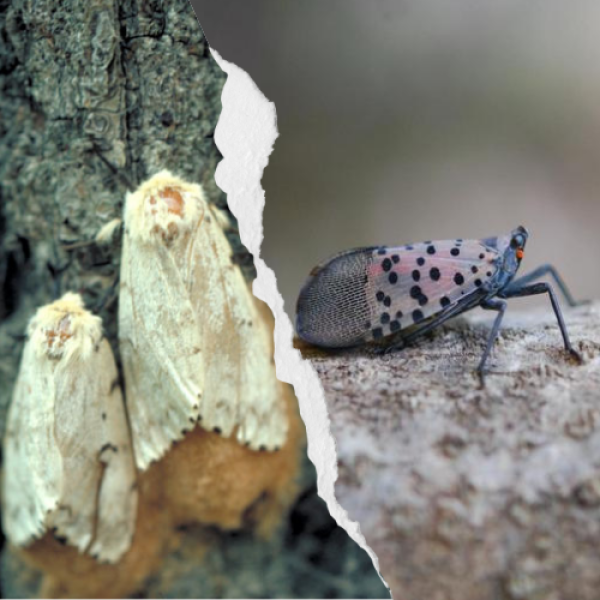
Author: Judy Rosovsky, State Entomologist, Agency of Agriculture, Food, and Markets
March 2022
Comparison of Lymantria dispar and Lycorma delicatula, the newly renamed spongy moth and the recent invasive spotted lanternfly.
The insect formerly known as the gypsy moth, a perennial pest in Vermont, has been renamed the spongy moth. The name change was spearheaded by the Entomological Society of America, which is engaged in an effort to change culturally insensitive names to names that are more universally acceptable. The term gypsy is a perjorative term for the Romani people. While the search for a new common name was taking place, we have been referring to the gypsy moth by its Latin name, Lymantria dispar dispar or by the initials of its Latin name. Those of you conversant with species names might recognize that a Latin name with three parts means it is referring to a subspecies.
The subspecies Lymantria dispar dispar is closely related to another moth, Lymantria dispar asiatica, the Asian gypsy moth. It is not clear whether the Asian gypsy moth will now be referred to as the Asian spongy moth or will get its own name.
At first glance, the spongy moth and the recent invader the spotted lanternfly (whose Latin name is Lycorma delicatula) would not appear to have much in common. The spongy moth, Lymantria dispar, is a moth. Moths fall under the insect order Lepidoptera, the moths and butterflies, and are characterized by scaly wings and a long tongue. The spotted lanternfly may look like a moth, but a closer glance at their mouthparts reveals them as true bugs, in the insect order Hemiptera. This group of insects is characterized by sucking-piercing mouthparts that look like a long straw running along the underside of their bodies.
Both insects are invasive species, though the spongy moth was brought to the US in the 1860’s to see if it could produce silk and compete with the silk moths. Instead they escaped from the laboratory they were brought to in Medford MA and have been defoliating oak trees for almost 150 years. Since there are still abundant oak in New England, the spongy moth are not killing the oaks, and they are more of a nuisance than a dreaded pest, but no-one welcomes the rain of frass (science word for insect poop) that comes down when they are feeding during an outbreak.
Spotted lanternfly (SLF) create an unpleasant rain too, as they rain honeydew on people and on our belongings. Unlike the spongy moth, the SLF excrete a sugar water mix that is a green sticky ooze. This adheres to surfaces and attracts sooty mold and stinging insects. SLF attack many host plants but usually move on after 1-3 days to another location. The plants they seem to damage the most are grapes, but they can cause more subtle problems with other crops. The sooty mold may block photosynthesis and thus affect plant growth and the feeding damage can harm small twigs and branches.
Spongy moth outbreak used to be episodic in Vermont. Bruce Parker at the Entomology Research Lab found that spongy moth population outbreaksin Vermont took place every 6-10 years. Defoliation of oak and other trees would take place for 2-3 years and then the natural enemy populations of spongy moths would increase to a level that would suppress the spongy moths. That periodic cycling stopped in 1990, when a fungus called Entomophaga maimaiga appeared unexpectedly and has successfully suppressed the spongy moth population in VT for the last 30 years. It is thought that the recent dry spells may have diminished the prevalence of the fungus. and allowed the moth population to soar unimpeded. Since and including 2016 we have had at least one very dry or drought season per year.
Which is the worst problem? At least the spongy moth can be controlled by natural enemies periodically, and if we have a rainy spring maybe they may go away soon. We aren’t sure what will happen because the arrival of the fungus has put us in new terrain. The fungus has controlled spongy moths since it got appeared and now that it has been diminished by drought we aren’t sure what will happen next. It is possible that the SLF will be curbed in time by natural or introduced enemies, but at the moment they are proliferating unchecked. The SLF have only been in the US since approximately 2014 and we are still learning their biology. Unlike the spongy moth, we have not yet developed a good lure or trap for them, so they are difficult to monitor and detect until they reach large numbers. SLF do not have a breeding population in Vermont at this time so a direct comparison will have to wait.